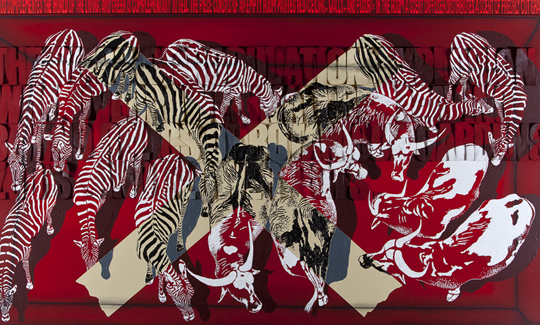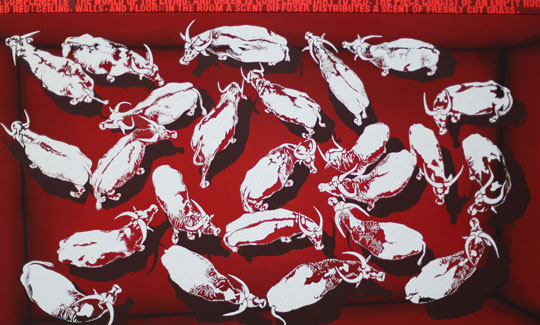Benni Efrat
Primal Scent, 2056, 2008
Saturday, 23.07.16, 20:00
Saturday, 21.01.17
More info:
04-6030800Benni Efrat
Primal Scent, 2056, 2008
Mixed media on canvas
Courtesy of the artist
The Israeli art scene has avoided the ecological discourse for years, unlike Europe and the United States, where this discourse has been dominant, gaining strength from the late twentieth century. It seems the tangible security threat in Israel diverted the attention of Israeli artists away from global threats, which appeared distant and abstract. It should also be noted that Zionism, at least in its early stages, was essentially anti-ecological. The aspiration to change nature – make the desert bloom, drain swamplands, massively develop the ground for settling purposes, initiate construction projects oblivious of topography – stemmed from a view of nature as a foreign entity that must be conquered and subdued, at times brutally, to suit the needs of the nation reclaiming its homeland.
Nevertheless, at the turn of the millennium the ecological discourse began to take root in Israel as well. This discourse is directly evident in the work of Benni Efrat. The reading of his works cannot avoid a serious discussion regarding the future of Earth and humanity. Inspired by a sense of mission, Efrat depicts the future possibilities facing mankind, his dystopian-utopian images serving him in a futuristic-archeological history project.
In Primal Scent, Summer 2056 Efrat attempts to reproduce the work of divine creation. He turns the "white cube" of the museum space into a "red room" where giant paintings of animals are presented: herds of giraffes, elephants, and buffalo painted white, with contour lines drawn with a virtuoso hand. Efrat aspires to touch the beginnings of the cosmos, the beginnings of life. A critical element of the work is invisible: the fresh smell of cut grass. A special drip system injects a strong scent essence into the room, produced especially for the artist – a primal, elemental scent, signaling to animals from kilometers away about access to food, water, rain, life, and rejuvenation. In the Biblical story of Creation, grass was created on the third day, prior to the animals, constituting the initial link in the food chain.
Efrat's red square is a super-technological "cave" in which nothing is "really" natural. Yet, this "cave" is also rooted in an artistic space recalling the theory that sees the famous "cave paintings" as complex symbolizations of the interaction between male and female elements in the world of animals and humans. The male is the "real," the "animal," the "red," while the female is subtle, delicate, caressing, and yet "all-penetrating." Thus, Efrat's work can also be read as a courting of the female element, an act of mourning and grief over its absence in our contemporary world.
Benni Efrat was born in 1940; lives and works in Israel.


